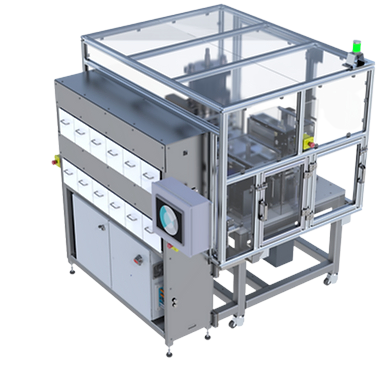
Summary
Re:Build DAPR Engineering was tasked with designing and producing a turn key automated system capable of testing, rotating, sorting and binning non-rigid porous objects at cycle time of under 5 seconds.Location: Confidential
Product: Foam Sorting Automated Work cell
Industry: Fuel Cells
Timeframe: 22-24 weeks
Background
Our client faced a significant automation challenge related to an existing testing machine. This machine was dedicated to sorting non-rigid porous parts through a process that involved controlled airflow to measure flow impedance and sort the parts accordingly. Despite the machine’s functionality, our client sought to dramatically enhance production capabilities. Re:Build DAPR Engineering undertook the task of replicating the previous sorting process but at an increased pace. The original machine operated with an unsatisfactory process cycle time, the goal was to optimize the entire process, which included testing, rotation, sorting, and binning, to fit under a tight 5-second cycle. The project encompassed the planning, execution, and testing of a cutting-edge automated foam sorting system, all while adhering to the clients’ high standards of quality and performance. From securing the clients approval to the successful completion of the Factory Acceptance Test (FAT) at Re:Build DAPR’s facilities and the subsequent installation and Site Acceptance Testing (SAT) at the clients manufacturing facility, Re:Build DAPR Engineering managed the entire process successfully. A significant hurdle in this project was the handling of non-rigid porous materials without causing any damage. Overcoming this challenge was pivotal to the success of the automated sorting system and showcased Re:Build DAPR Engineering’s innovation and engineering expertise.Challenges & Solutions
- Precise Singulation and Handling of Non-Rigid Porous Material: The first and most crucial challenge involved the precise singulation and handling of non-rigid, porous materials from a stacked configuration without incurring any damage to the parts. Traditional pick-and-place technology proved inadequate in dealing with these delicate materials as they often became distorted or damaged during handling. To address this, Re:Build DAPR Engineering leveraged vacuum cups to gently pick and place the parts. Determining the optimal flow rate for the vacuum cups was achieved through extensive proof-of-concept testing, ensuring the safe and precise singulation of the porous material.
- Redesigning the Tester and Press for High-Speed Operation: The existing machine had been using a repurposed arbor press for its operations. However, this press was found to be unsuitable and prone to cracking under the demands of the application. In response, Re:Build DAPR Engineering initiated a comprehensive redesign of the press, creating a robust weldment capable of withstanding the required pressure without the risk of fracture. Furthermore, Re:Build DAPR optimized the design of the tester by reducing its stroke, leading to a significant reduction in cycle time and a substantial improvement in production efficiency.
- Integration of Automation Within Existing Equipment Constraints: The project’s process design presented a unique set of constraints due to the dimensional requirements of the existing equipment. To tackle this challenge, Re:Build DAPR Engineering demonstrated an exceptional level of creative problem-solving while adhering to sound engineering principles. This involved the development of a customized automated robotic solution that effectively operated within these constraints, highlighting the team’s ability to think “out of the box” while maintaining engineering integrity.
- Seamless Loading and Unloading for Continuous Testing: One of the fundamental requirements for the machine’s design was to allow the client to safely load and unload products without disrupting the testing cycle. This aspect necessitated meticulous attention to detail and precision engineering to ensure a smooth and uninterrupted testing process, ultimately enhancing the overall efficiency of the system.
Successes
The successful resolution of these challenges underscores Re:Build DAPR Engineering’s commitment to delivering innovative, effective, and efficient solutions tailored to our client’s specific needs. The project exemplified our team’s capacity to surmount complex engineering hurdles, showcasing our company’s exceptional capabilities in the design and construction of advanced automated machinery.
